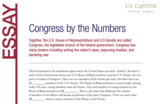
Together, the U.S. House of Representatives and U.S Senate are called Congress, the legislative branch of the federal government.
- Subject:
- History
- Material Type:
- Reading
- Provider:
- U.S. Capitol Visitor Center
- Date Added:
- 08/11/2022


Together, the U.S. House of Representatives and U.S Senate are called Congress, the legislative branch of the federal government.

In this activity (which is appropriate for introducing the Constitution) students match primary source documents to clauses from Article 1 of the Constitution. Students find six pairs, which reveal the powers of Congress. Online resource.

What is a biography? Who are the people who represent Americans in Congress? How do you compose a biography about one of the representatives?
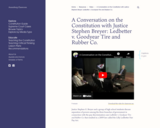
Justice Stephen G. Breyer and a group of high school students discuss separation of powers among the three branches of government in connection with the pay discrimination case Ledbetter v. Goodyear Tire and Rubber Co. that resulted in a 2009 law called the Lilly Ledbetter Fair Pay Act.
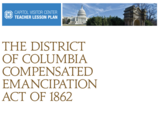
The D.C. Compensated Emancipation Act was an important and symbolic victory. It was part of a larger struggle over the meaning and practice of freedom and citizenship. What does it mean to be a participating member of society? What does freedom and citizenship mean?

This activity is designed to accompany the contextual essay “‘The Negroes’ Temporary Farewell’: Jim Crow and the Exclusion of African Americans from Congress, 1887–1929,” from the Black Americans in Congress website, history.house.gov/exhibitions-and-publications/baic/black-americans-in-congress/. Students have the opportunity to learn more about the Black Americans who served in Congress from 1887 to 1929. Students are encouraged to analyze the role African-American Representatives played in Congress during this era, as well as the ways in which they may have changed the institution.
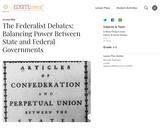
This lesson focuses on the debates among the U.S. Founders surrounding the distribution of power between states and the federal government. Students learn about the pros and cons of state sovereignty vs. federalism and have the opportunity to argue different sides of the issue.

This activity is designed to accompany the contextual essay “‘The Fifteenth Amendment in Flesh and Blood’: The Symbolic Generation of Black Americans in Congress, 1870–1887,” from the Black Americans in Congress website, history.house.gov/exhibitions-and-publications/baic/black-americans-in-congress/. Students have the opportunity to learn more about the Black Americans who served in Congress from 1870 to 1887. Students are encouraged to analyze the role African-American Representatives and Senators played in Congress during this era, as well as the ways in which they may have changed the institution.

This activity is designed to familiarize students with the legislative process and increase the students awareness of their district Representative and the responsiblities of Members of the U.S. House of Representatives.

This activity familiarizes students with the legislative process and introduces them to basic legislative vocabulary.

This activity is designed to help students get to know the Representatives serving their district in the U.S. House of Representatives. Students will be tasked with researching and analyzing the political background, voting history, and floor activities of the Representatives serving several local districts.

This resource from the History, Art & Archives of the United States House of Representatives website includes background information, a fact sheet, and teaching tips about this history of Hispanic Americans in Congress.
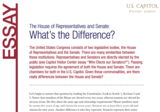
The United States Congress consists of two legislative bodies, the House of Representatives and the Senate. There are many similarities between these institutions, so what are the differences?

Congressional Apportionment: The United States Senate consists of how many members? The answer is fairly simple: with two members apiece representing each of the fifty states, the total is one hundred. How about the House of Representatives? The answer is much more complicated.
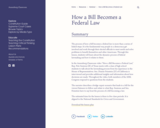
The process of how a bill becomes a federal law is more than a series of linked steps. It is the fundamental way people in a democracy get involved and work through their elected officials to meet needs and solve problems to benefit themselves and other Americans. Through this lesson, students will learn about the dynamic process of federal lawmaking and how it relates to them.
The estimated time for the lesson is three to five class periods. It is aligned to the National Standards for Civics and Government.

This video covers part two of article one of the Constitution. It details how a bill becomes a law and can be used for teaching kids or adults.

Find your congressmen

This activity is designed to accompany the contextual essay “‘I’m No Lady, I’m a Member of Congress’: Women Pioneers on Capitol Hill, 1917–1934,” from the Women in Congress website, history.house.gov/ exhibition-and publications/wic/women-in-congress/. Students have the opportunity to learn more about the women who served in Congress from 1917 to 1934. Students are encouraged to analyze the role women Representatives and Senators played in Congress during this era, as well as the ways in which they may have changed the institution.
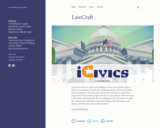
Learn how laws are made in an updated version of LawCraft. Select a district to represent in the House of Representatives, then review letters from constituents. You'll dig into survey data and select an issue that's important to you and the people who live in your district. Take that issue to the House and jump into the law-making process. See if you can make the compromises necessary to get your bill passed by the House and Senate and still make a law you're proud of.

Lawcraft from icivics.org. this online game helps students experience the ins and outs of taking an idea and turning it into a law while dealing with the political travails in Washington.